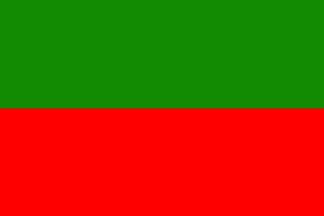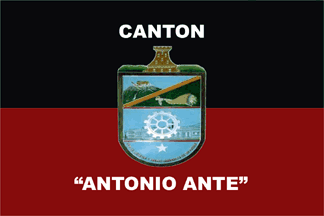 klaus-michael schneider
klaus-michael schneider
Keywords: imbabura | antonio ante | atuntaqui |
Links: FOTW homepage | search | disclaimer and copyright | write us | mirrors

Last modified: 2021-08-26 by  klaus-michael schneider
klaus-michael schneider
Keywords: imbabura | antonio ante | atuntaqui |
Links: FOTW homepage |
search |
disclaimer and copyright |
write us |
mirrors
 image by Ivan Sache, 10 September 2018
image by Ivan Sache, 10 September 2018
Parishes:
See also:
Antonio Ante canton (45,184 inhabitants; 7,900 ha) is located in the center
of Imbabura province. The canton is composed of two urban parishes (Atuntaqui,
capital; Andrade Marín; grouped, 19,216 inh.) and four rural parishes (San Roque,
8,599 inh.; Chaltura, 2,840 inh.; Natabuela, 4,288 inh.; Imbaya, 1,110 inh.).
Atuntaqui was the last stronghold of the Caras; the Atuntaqui fortress was
served by 5,000-6,000 soldiers. The 15th and last Shyri (Caras ruler of the
Kingdom of Quito) was defeated during the battle of Atuntaqui by Huayna Cápac,
which completed the Inca conquest of the area.
During the colonial period, Atuntaqui, known as Tontaqui, was a dependency of Otavalo.
Julio
Miquel Aguinaga established in 1924 Atuntaqui the Imbabura Cloth Factory, a
cotton mill that employed 1,000 workers (out of the 3,000 inhabitants of the
town) and made the town the biggest industrial center of the province. The
transport of the factory's machinery prompted the establishment of a railway
line, which superseded transport by mules, once the main source of income in the
town. The factory was proclaimed Cultural National Heritage on 20 September
2001.
Antonio Ante canton was established on 12 February 1938, separating
from Ibarra.
http://www.antonioante.gob.ec/
Canton website
Ivan Sache, 10
September 2018
The canton's namesake is a hero of the South American independence, Dr.
Antonio Ante López de la Flor (1771-1836). Graduated Doctor in Civil and Canon
Law at Universidad de Santo Tomás in Quito in 1797, Ante was among the most
brilliant scholars of the time. Attending the clandestine meetings held in
Manuela Cañizares' home to prepare the patriotic insurrection, he was appointed
during the night of 9 August 1809 by the members of the self-proclaimed
Sovereign Government to notify Count Ruiz de Castilla, President of the Quito
colonial administration, he had been overthrown. In the aftermath of the 10
August 1809 Revolution, Ante was jailed; he could escape, while several of his
brothers in arms were executed on 2 August 1810.
Ante joined the army
organized by Colonel Carlos Montúfar, contributing
to the victorious battle of San Miguel de Chimbo, fought on 25 July 1812. He was
also part of the battle of Mocha, fought on 2 September 1812. General Toribio
Montes, winner of the battle, was appointed President of the Quito colonial
administration and proposed reconciliation with the patriots. In 1817, his
successor, General Juan Ramírez, resumed persecution of the Quito patriots. Ante
planned and led in 1818 a plot aiming at killing all the Spaniards living in
Quito. Jailed in Ceuta, Ante escaped and came back to Quito; appointed
Representative of the town, he attended the First Constituent Assembly gathered
by General Juan José Flores in 14 August 1830 in Riobamba and the Ordinary
Congress inaugurated on 10 September 1833.
http://www.enciclopediadelecuador.com/personajes-historicos/dr-antonio-ante/
Enciclopedia del Ecuador
The flag and arms of Antonio Ante were
adopted on 29 July 1947.
The flag of Antonio Ante is made of two horizontal
stripes, the upper, green, as a symbol of industry, agriculture and of "the
aspiration to reach a higher civilization index thanks to work and force", and
the lower, bright red, as a symbol of energy, of the burning blood of the spirit
of liberty, and of love for independence that has always characterized the local
people.
The coat of arms of Antonio Ante, designed by Heriberto Neptalí Rocha, a priest from Atuntaqui, is composed of:
An heraldic shield in Old Castile style, orled or and outlined crimson,
composed of two rectangles and a quarter.
A bend sinister gules, as the
exaltation of bellicose spirit, divides the first rectangle into two parts. The
first part with a blue field, beautiful azure of the sky, charged with Mount
Imbabura ensigned by a powerful lion gardant flanked by a spear, which watches
from its high tower the northern border of the homeland. The second part with an
emerald field [blue on the drawing] features a cornucopia and cropping tools, as
symbols of the crops and resources of this rich and beautiful region.
The
second rectangle, with a blue background, features the manufacturing district
charged in the center with a sprocket representing industry.
The quarter, also blue, shows a silver star in the sky that saw the
birth of the canton's namesake, Antonio Ante.
Written in blood
and fire letters around the shield, the motto "Amé la libertad y surgió la
grandeza de un pueblo" (I loved freedom and the greatness of a people emerged).
The shield surmounted by an Inca fortress, symbol of the historic fortress of Atuntaqui erected by the 15th and last Shyri (ruler of the
Kingdom of Quito), which included: Pailatola, Orozcotola, the Sun's Temple of
the Caras dynasty and the Great War Drum, whose call could be hear up to San
Pablo.
http://www.antonioante.gob.ec/AntonioAnte/index.php/canton/simbolos-del-canton
Canton website
The flag in
regular use matches the official description.
Photos
http://www.antonioante.gob.ec/AntonioAnte/index.php/noticias/378-jovenes-en-antonio-ante-cumplieron-juramento-a-la-bandera
http://www.elnorte.ec/imbabura/vencieron-las-barreras-para-ser-las-mejores-estudiantes-de-su-colegio-GAEN41833
Ivan Sache, 10 September 2018
 image by Jens Pattke and Falko Schmidt, 3 July
2007
image by Jens Pattke and Falko Schmidt, 3 July
2007
This flag, based on a photo, must
be a kind of "ceremonial" flag, with the municipal coat of arms and inscription
added. The upper stripe is very dark green and not black - those "ceremonial"
flags appear to use vary dark color shades.
Source:
http://ame.gob.ec/ec/2010/05/20/canton-antonio-ante/
Ivan Sache,
10 September 2018